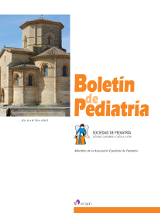Macrohematuria: características clínicas, epidemiológicas y orientación diagnóstica
C. Sánchez-Villares Lorenzo, S. Fernández Luis, N. Abad Moreno, C. Criado Muriel
Bol. Pediatr. 2015; 55 (234): 254 - 261
Introducción. La macrohematuria es un motivo de consulta que, aunque es poco frecuente, es alarmante para los padres y el diagnóstico supone un reto para el pediatra debido a la diversidad de causas, tanto renales como extrarrenales,que la pueden provocar. Material y métodos. Estudio descriptivo, observacional y retrospectivo de los casos de macrohematuria, seguidos en Nefrología Infantil en el Complejo Asistencial de Salamanca entre enero 2008 y julio de 2014, estudiando las características clínicas, epidemiológicas y la orientación diagnóstica. Resultados. La muestra de estudio fue de 40 pacientes. El 75% derivado desde Urgencias y el resto desde Atención Primaria y otras consultas. Se clasificó a 23 (57,5%) pacientes en macrohematuria de origen glomerular: 10 probable glomerulonefritis aguda postinfecciosa (GNAP), 6 probable nefropatía IgA y 7 púrpura de Schönlein-Henoch (PSH). En las GNAP se confirmó la etiología en 4 casos, 3 faringoamigdalitis estreptocócicas y una neumonía por Mycoplasma pneumoniae. El 17,5% (7 casos) se clasificó como hematuria no glomerular y en el 25% (10 niños) no se llegó a ningún diagnóstico. Conclusiones. Ante un episodio de macrohematuria es importante diferenciar si es de origen glomerular o no glomerular, realizando inicialmente una anamnesis detallada y exploración física completa. En función de los hallazgos clínicos se realizan pruebas complementarias. Destacar en el análisis urinario la morfología de los hematíes, por ser una prueba no invasiva, fácil de realizar y útil para orientar el diagnóstico. Tras las pruebas complementarias, en el 25% de los pacientes de nuestra revisión no se ha llegado a ningún diagnóstico.
Macrohematuria: clinical, epidemiological and diagnostic orientation characteristics
Introduction. Gross hematuria is a reason for consultation which, although rare, is alarming for parents, and the diagnosis represents a challenge for the pediatrician, due to the different renal and extra-renal causes. Material and methods. Retrospective, observational and descriptive study of the cases of gross hematuria in the Department of Pediatric Nephrology of the Healthcare Complex of Salamanca from January 2008 to July 2014. The study analyzes the clinical and epidemiological characteristics of each case as well as their diagnostic orientation. Results. The sample of the study was 40 patients. 75% of them were referred from emergency, and the rest from Primary Care and other departments. 23 patients (57.5%) were classified with macrohematuria of glomerular origin: 10 of them had a probable acute post-infectious glomerulonephritis (GN), 6 had a probably IgA nephropathy, and 7 showed a probable Henoch-Schönlein purpura (HSP). In the cases of acute GN, the etiology was confirmed in 3 with streptococcal pharyngoamigdalitis and one with pneumonia by Mycoplasma pneumoniae. 17.5% cases (7 patients) was classified as non-glomerular hematuria, and in 25% (10 children), no diagnosis was reached. Conclusions. When faced with an episode of gross hematuria, it is important to ascertain whether it has a glomerular or non-glomerular origin, with an detailed history, physical examination and complementary test depending on the clinical findings. Study the morphology of red blood cells in urine analysis is an easy, non-invasive and useful test, in the orientation of a diagnosis. No diagnosis was reached in 25% of the patients of our review.
Artículo completo (PDF) (149 kb.)
- Nefrourología
